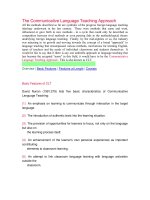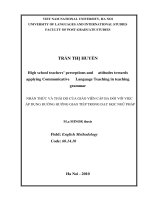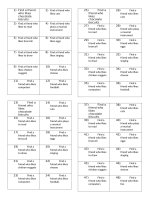The Communicative Language Teaching Approach.doc
Bạn đang xem bản rút gọn của tài liệu. Xem và tải ngay bản đầy đủ của tài liệu tại đây (67.89 KB, 4 trang )
The Communicative Language Teaching Approach
All the methods described so far are symbolic of the progress foreign language
teaching ideology underwent in the last century. These were methods that came
and went, influenced or gave birth to new methods - in a cycle that could only be
described as competition between rival methods or even passing fads in the
methodological theory underlying foreign language teaching. Finally, by the mid-
eighties or so, the industry was maturing in its growth and moving towards the
concept of a broad "approach" to language teaching that encompassed various
methods, motivations for learning English, types of teachers and the needs of
individual classrooms and students themselves. It would be fair to say that if
there is any one umbrella approach to language teaching that has become the
accepted "norm" in this field, it would have to be the Communicative Language
Teaching Approach. This is also known as CLT.
Overview | Basic Features | Features at Length | Caveats
Basic Features of CLT
David Nunan (1991:279) lists five basic characteristics of Communicative
Language Teaching:
(1) An emphasis on learning to communicate through interaction in the target
language.
(2) The introduction of authentic texts into the learning situation.
(3) The provision of opportunities for learners to focus, not only on the language
but also on
the learning process itself.
(4) An enhancement of the learner's own personal experiences as important
contributing
elements to classroom learning.
(5) An attempt to link classroom language learning with language activation
outside the
classroom.
Top | Basic Features | Features at Length | Caveats
CLT Features at Length
Finnochiaro and Brumfit (1983:91-93) compiled this list of CLT features way back
in 1983 as a means of comparing it to the Audiolingual Method. Below each
feature in blue italics is the feature of ALM to which it was being compared.
(1) CLT: Meaning is paramount.
ALM: Attends to structure and form more than meaning.
(2) CLT: Dialogs, if used, center around communicative functions and are not
normally memorized.
ALM: Demands more memorization of structure-based dialogs.
(3) CLT: Contextualization is a basic premise.
ALM: Language items are not necessarily contextualized.
(4) CLT: Language learning is learning to communicate.
ALM: Language Learning is learning structures, sounds or words.
(5) CLT: Effective communication is sought.
ALM: Mastery or "overlearning" is sought.
(6) CLT: Drilling may occur, but peripherially.
ALM: Drilling is a central technique.
(7) CLT: Comprehensible pronunciation is sought.
ALM: Native-speaker-like pronunciation is sought.
(8) CLT: Any device which helps the learners is accepted - varying according to
their age,
interest, etc.
ALM: Grammatical explanation is avoided.
(9) CLT: Attempts to communicate may be encouraged from the very beginning.
ALM: Communicative activities only come after a long process of rigid drills
and exrecises.
(10) CLT: Judicious use of native language is accepted where feasible.
ALM: The use of the students' native language is forbidden.
(11) CLT: Translation may be used where students need or benefit from it.
ALM: Translation is forbidden at early levels.
(12) CLT: Reading and writing can start from the first day, if desired.
ALM: Reading and writing are deferred until speech is mastered.
(13) CLT: The target linguistic system will be learned best through the process
of struggling to
communicate.
ALM: The target linguistic system will be learned through the overt teaching
of the patterns of
the system.
(14) CLT: Communicative competence is the desired goal.
ALM: Linguistic competence is the desired goal.
(15) CLT: Linguistic variation is a central concept in materials and methods.
ALM: Varieties of language are recognized but not emphasized.
(16) CLT: Sequencing is determined by any consideration of content function, or
meaning which
maintains interest.
ALM: The sequence of units is determined solely on principles of linguistic
complexity.
(17) CLT: Teachers help learners in any way that motivates them to work with
the language.
ALM: The teacher controls the learners and prevents them from doing
anything that conflicts with
the theory.
(18) CLT: Language is created by the individual often through trial and error.
ALM: "Language is habit" so error must be prevented at all costs.
(19) CLT: Fluency and acceptable language is the primary goal: accuracy is
judged not in the
abstract but in context.
ALM: Accuracy, in terms of formal correctness, is a primary goal.
(20) CLT: Students are expected to interact with other people, either in the
flesh, through pair and
group work, or in their writings.
ALM: Students are expected to interact with the language system,
embodied in machines or
controlled materials.
(21) CLT: The teacher cannot know exactly what language the students will
use.
ALM: The teacher is expected to specify the language that students are to
use.
(22) CLT: Intrinsic motivation will spring from an interest in what is being
communicated by the
language.
ALM: Intrinsic motivation will spring from an interest in the structure of the
language.









